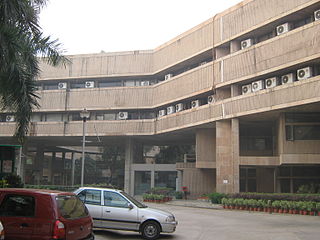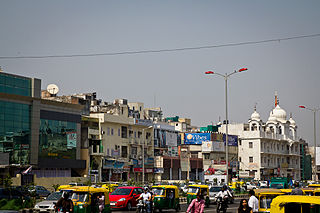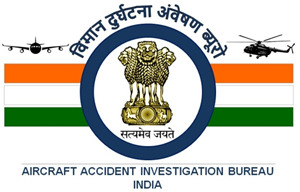
New Delhi is the capital of India and a part of the National Capital Territory of Delhi (NCT). New Delhi is the seat of all three branches of the Government of India, hosting the Rashtrapati Bhavan, Sansad Bhavan, and the Supreme Court. New Delhi is a municipality within the NCT, administered by the NDMC, which covers mostly Lutyens' Delhi and a few adjacent areas. The municipal area is part of a larger administrative district, the New Delhi district.

Indira Gandhi International Airport is the primary international airport serving New Delhi, the capital of India, and the National Capital Region (NCR). The airport, spread over an area of 5,106 acres (2,066 ha), is situated in Palam, Delhi, 15 km (9.3 mi) southwest of the New Delhi Railway Station and 16 km (9.9 mi) from New Delhi city centre.

7, Lok Kalyan Marg (7LKM), formerly 7, Race Course Road, is the official residence and principal workplace of the Prime Minister of India. Situated on Lok Kalyan Marg, New Delhi, the official name of the Prime Minister's residence complex is Panchavati. It is spread over 4.9 hectares of land, comprising five bungalows in Lutyens' Delhi, built in the 1980s, which are the Prime Minister's office, residency zone and security establishment, including one occupied by Special Protection Group (SPG) and another being a guest house. However, even though there are 5 bungalows, they are collectively called 7, Lok Kalyan Marg. It does not house the Prime Minister's Office but has a conference room for informal meetings.

Safdarjung area consists of mainly two localities in South Delhi, namely Safdarjung Enclave and Safdarjung Development Area (SDA). There are several districts in Delhi located south of the tomb of Safdarjung, the second Nawab of Awadh, an important administrator in the Mughal Imperial courts in Delhi, under Muhammad Shah in the 18th century.

Lutyens' Delhi is an area in New Delhi, India, named after the British architect Edwin Lutyens (1869–1944), who was responsible for much of the architectural design and building during the period of the British Raj, when India was part of the British Empire in the 1920s and 1930s and 1940s. This also includes the Lutyens Bungalow Zone (LBZ).

The Ministry of Civil Aviation in India is the nodal ministry responsible for the formulation of national policies and programmes for the development and regulation of civil aviation. It devises and implements schemes for the orderly growth and expansion of civil air transport in the country. Its functions also extend to overseeing airport facilities, air traffic services and carriage of passengers and goods by air. The ministry also administers the implementation of the Bharatiya Vayuyan Adhiniyam, 2024, Aircraft Rules, 1937 and is administratively responsible for the Commission of Railway Safety.

Rajiv Gandhi Bhawan is the corporate headquarters of Airports Authority of India (AAI). AAI which functions under the Ministry of Civil Aviation and manages most of the airports in India. The Indian Ministry of Civil Aviation is co-located in the same building.

Sri Aurobindo Marg or Aurobindo Marg, is an important South Delhi north-south arterial road connecting historic Safdarjung's Tomb to Qutab Minar. The road is named for Sri Aurobindo Ghosh; the Delhi campus of Sri Aurobindo Ashram is located on the road. The road was originally known as Mehrauli Road.
Safdarjung Road is a main road in New Delhi, India, named after the 18th century Tomb of Safdarjung near it. At the north end, the road stretches from the junction of the Teen Murti Marg, Akbar Road, Rajaji Marg and Lok Kalyan Marg, which is a roundabout. At the south end it stretches up to the junction of Prithviraj Road, Tughlaq Road and Sri Aurobindo Marg. There is a single junction/crossing at the Kemal Atatürk Marg and Dr APJ Abdul Kalam Road section.

Japan Air Lines Flight 471 was a Japan Air Lines international flight from Don Mueang International Airport in Bangkok, Thailand, to Palam International Airport in New Delhi, India. On 14 June 1972 the Douglas DC-8-53 operating the flight, registered JA8012, crashed short of the New Delhi airport, killing 86 of the 89 occupants: 10 of 11 crew members, and 76 of 78 passengers. Four people on the ground were also killed.
The Directorate General of Civil Aviation (DGCA) is a statutory body of the Government of India to regulate civil aviation in India. It became a statutory body under the Aircraft (Amendment) Act, 2020. The DGCA investigates aviation accidents and incidents, maintains all regulations related to aviation and is responsible for issuance of licenses pertaining to aviation like PPL's, SPL's and CPL's in India. It is headquartered along Sri Aurobindo Marg, opposite Safdarjung Airport, in New Delhi. The Government of India is planning to replace the organisation with a Civil Aviation Authority (CAA), modelled on the lines of the American Federal Aviation Administration (FAA).

Air Force Station Hindon is an Indian Air Force base under the Western Air Command (WAC). It is the biggest and largest air base in Asia. Its area measured 14 km rounded and 10.25 square kilometres (3.96 sq mi). This base celebrates Air Force Day on 8 October. It is located near Loni Ghaziabad in the state of Uttar Pradesh in the National Capital Region on the outskirts of Delhi, close to the Hindon River. Starting 2006, the annual Air Force Day Parade venue was shifted from Palam Airport to Hindon. There is one runway, aligned east–west (09-27), of 9,000 feet (2,700 m) length x 150 feet (46 m) width. The military airbase serves as the home of the IAF C-17 Globemaster and the IAF C-130J Super Hercules, the backbone of Strategic Heavy Air Lift division of the Indian Air Force. The Airports Authority of India (AAI) operates a civil enclave at Hindon as part of the government's Regional Connectivity Scheme (RCS).
Fursatganj Airport or Fursatganj Airfield is an under-construction domestic airport and functional airfield at Fursatganj of Amethi district in the Indian state of Uttar Pradesh.

Indian Airlines Flight 440 was a flight on 31 May 1973 that crashed while on approach to Palam Airport killing 48 of the 65 passengers and crew on board.

The Indian Air Force Museum Palam, is the museum of the Indian Air Force (IAF), and is located at the Palam Air Force Station in Delhi Cantonment, New Delhi, India. It was established in 1967 and exhibits details about combat operations undertaken by the air force depicting its history since its formation in 1932. Also on display are various aircraft and equipment on the IAF’s inventory since its inception. The museum was the only one of its kind in India until the opening of the Naval Aviation Museum in Goa in 1998 and HAL Aerospace Museum in Bangalore in 2001.

The Aircraft Accident Investigation Bureau (AAIB) is a division of the Ministry of Civil Aviation, Government of India which investigates aircraft accidents and incidents in India.

Indira Gandhi Rashtriya Uran Akademi (IGRUA) is a public pilot training institute located at Fursatganj Airfield in Uttar Pradesh, India. Established in 1985, it is an autonomous institution under the Ministry of Civil Aviation, Government of India.

Rajiv Gandhi National Aviation University (RGNAU) is an autonomous central university at Fursatganj Airfield in Uttar Pradesh, India, for aviation studies and research. It is under the administration of the Ministry of Civil Aviation of the Government of India, constituted by an Act of Parliament in 2013 and physically established in 2018. It is India's first aviation university.

















